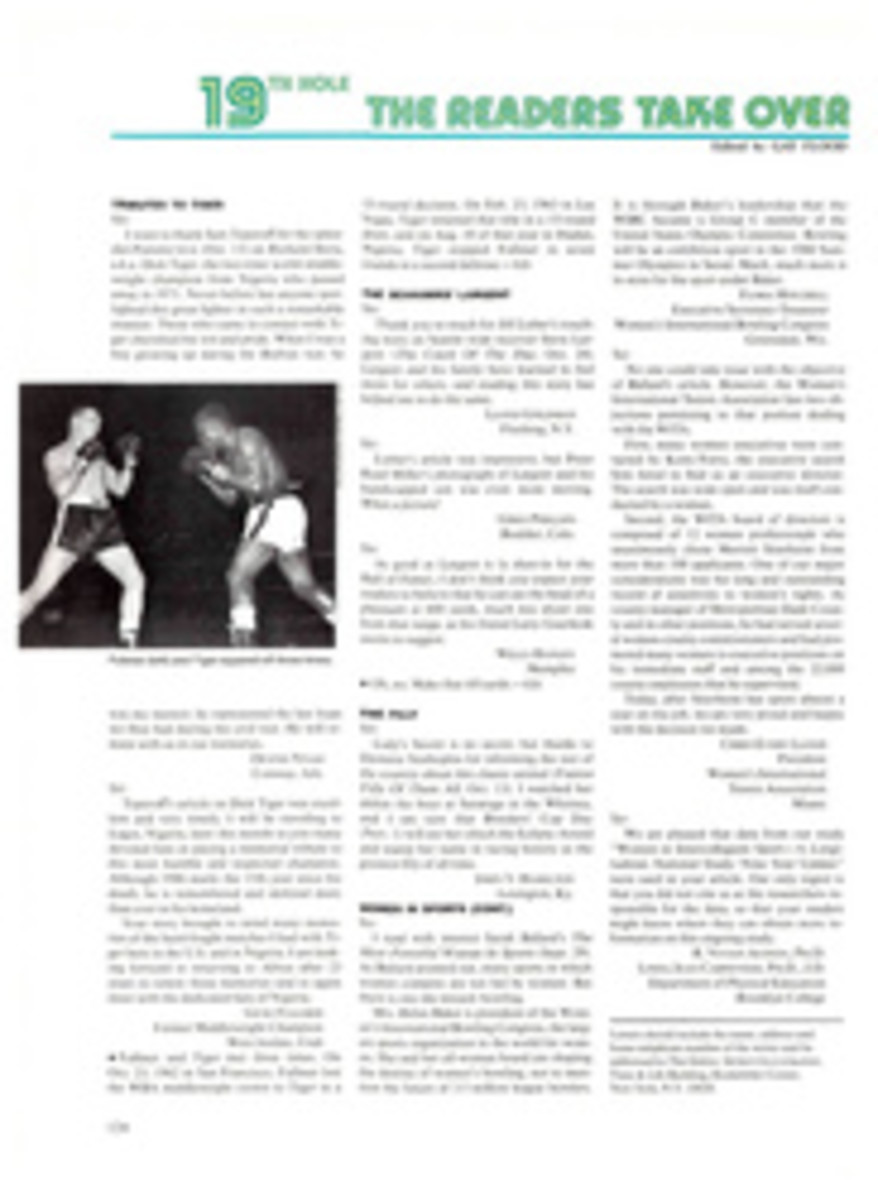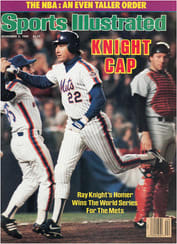
A POOLSIDE VISIT WITH THE MEMBERS OF THE U.S. WOMEN'S WATER POLO TEAM
Ruby Rodriguez is preparing to goon her fiancè, Jim Mendoza. They're at Makapuu Beach in Hawaii, and Ruby brings him a shaved ice. "Strawberry," she says. Ruby neglects to mention she has laced it with Tabasco sauce. Jim, a big football player kind of guy, bites in. His face reddens. His mouth puckers. His tongue wags. His eyes cross.
"Oooooooooeeeeee!" he yelps.
Jim Mendoza has just been gooned.
Gooning is what water polo women do just about all the time that they're not submerged. And Ruby is the nom de goon of Maureen O'Toole, the hole setter on the U.S. national team, which was in Hawaii this July training for the World Aquatics Championships in Madrid. For the first time, women's water polo had official standing at the worlds, though no one expects it to be sanctioned as an Olympic event until at least 1992.
Men's water polo has always been such a wham-bam bang-up affair that the milder women's game just hasn't been taken very seriously. The most exposure that the women have ever had came last year at an international tournament in La Rochelle, France, where Marybeth (Rambo) Kolding of the U.S. had her suit ripped off by a Canadian defender. "I got mauled so badly that my boobs hung out," recalls Kolding. "It totally grossed me out." So Rambo surfaced to claim a foul. Unfortunately, when she popped into view, the referee almost swallowed his whistle. He recovered and slapped the defender with a 45-second ejection. But stripped of their dignity, the Goonies lost 7-5 in the first round.
Joining the Goon Squad is like signing up with the Green Berets, except that you have to pay your own way. Coach Sandy Nitta demands total commitment and a four-year enlistment. Until this year, the players were such amateurs that they even paid their own expenses on trips. They each typically shell out $5,000 a year to play. Nitta, who receives no salary, occasionally has subsidized her players' lodging and airfare.
The team went on its three-week training trip to Hawaii only after U.S. Water Polo, Inc., the governing body of the sport, coughed up a $13,600 grant and the United States Olympic Committee forked over another $15,000 for the trip to Madrid. Of course, the Goons probably would have received no funding at all if Dr. Ralph Hale, the USWP president, weren't the team physician. Still, it has been a labor of love for the players. "I've always been broke because of water polo," says driver Simone (Reebok) La Pay. "So what if I have to eat macaroni and cheese every night for dinner?"
Goonies tend to answer to names like Reebok, Trinket, Kit Kat, Fifi Fontana and Gidget Gaylord. It confounds opponents and guys in bars. The 17 squad members who worked out in Hawaii ranged in age from 20 to 34. Three of them—Robin (Priss) Dressel, Dion (Jared) Gray and Lyn (Ralph) Taylor—are mothers, with kids in tow.
The roster included a computer programmer, an aerobics instructor, an Olympic gold medalist, a nurse, a geneticist, a nutritionist and an interior decorator. The top player, O'Toole, picks up pocket change sculling a gondola in Naples, Calif., while the coach made her fortune on the poker tables of Las Vegas.
With her squinty eyes and plump cheeks, Nitta always seems amusedly alert. She's a regular camp counselor. She draws mustaches on the players while they're asleep, short-sheets their beds, and once had her assistant, Scott Hinman, convince one painfully gullible Goon that salami grows on trees.
At 15, Nitta swam the breaststroke for the U.S. in the 1964 Olympics. She later taught swimming for a decade and played seven-card stud on the side, well enough to make it to the final day of the World Series of Poker in 1983. Nitta also gambles on unlikely players. She hit the jackpot with Jill (Jackie) Sterkel, the second American woman to compete on three Olympic swim teams. "Swimming is such a solitary sport," says Nitta, "that swimmers don't necessarily make good team players." Sterkel was 15 in 1976 when the East German women won 11 of the first 12 gold medals at the Olympics in Montreal. She swam the third leg of the 13th and final event, the 4 X 100 freestyle relay. "We won because we pulled for each other," she says. "The other countries didn't know how." Now Sterkel is the speediest sprinter on a team of sprinters. "It's so much easier to win with other people," she says. "You have others to celebrate with."
But it's hard finding worthy opponents among women. That's why the team was in Hawaii scrimmaging against bruising pickup teams of young men. But even when they don't play men, the women end up with their share of busted knees and broken noses. And though dunking, butting, choking and gouging aren't as common as they are in men's water polo, the women's game can be such a struggle that players are now required to wear two suits during international competition. Nitta used the practice sessions in Hawaii to float an array of stratagems past her players. She employed such unorthodox water polo tactics as double-teaming the hole setter and jamming three goalies in the cage. She pooled nine different offenses and six defenses at full strength and had another seven of each for man-up or man-down situations. The squad worked out in two three-to four-hour sets, at 5 a.m. and 7 p.m.
After one grueling stretch of practices, the Goon Squad took a holiday. They flopped and frolicked at a beach on Oahu's north shore, while the moms tended to their young. Two-year-old Andy Dressel had just thrown up. "Mango," said Robin, his mother.
"How can you explain to people why you're still running off and playing water polo when you're 28 years old with a family?" asks Dressel. Her husband, Kenny, an Air Force pilot, was on duty in Arizona. So Robin and Andy camped out with Nitta, Dion Gray and her son, Jared, at the Honolulu home of Dr. Hale. The rest of the Goon squad was sausaged into four rooms at a Waikiki hotel.
Dressel is a driver; the other two moms play that most maternal of positions, goalie. "I don't think being mothers has made them better goalies," says Nitta, "although being goalies may have made them better mothers." Dressel found it easier to come back after having Andy. "I don't care what drills Sandy throws at me," she says. "After experiencing labor, everything else is a cinch."
The morning workouts began with a 500-yard warmup, followed by four 200-yard sprints, a 20-yard swim, four 50's, a 100, four 25's, a 300, 14 50's and 10 25's, the last 10 while pushing a ball along. The players moved the ball methodically up and down the pool, darting along the surface of the water. Then came a half hour of legwork, lunging in the water and passing drills. After several hours of this, they were pretty well worn out.
Except for O'Toole, who looked fresh enough to swim the English Channel. At 25 she's the premier woman water poloist in the world. Like most of her sister Goons, O'Toole doesn't care much for swimming. "I don't like getting my hair wet," she says. For a game, though, she'll take the plunge. As a hole setter, O'Toole is unpredictable, totally concentrated, with a sharp sense of what's happening in the whole pool. She is a tireless swimmer and a precise passer, with a periscope arm for finding the cage with the ball.
Most female players lie back on their hips in the water, but O'Toole's eggbeater kick is so powerful that she can raise herself above the other players. She plays like a guy perhaps because she got her early training against guys. At Woodrow Wilson High in Long Beach, Calif., O'Toole started on the varsity. The boys' varsity.
Of the 65 goals the U.S. scored during its six games at the Canadian Women's International in February, O'Toole had 33. "If the other team's pregame talk is an hour long," says Nitta, "half is usually spent on how to contain Maureen."
When the team arrived in Spain in August, it was ranked second and scheduled to face six countries for the world championship. But top-ranked Australia was the match that really mattered. The Goons tied Canada 7-7 in the opener, then deep-sixed Norway (14-3), Hungary (11-8) and West Germany (13-3). A tie with third-ranked Holland would have kept their hopes for gold alive, but the speedy Dutch staved off a power play in the final 35 seconds to win 8-7.
In its final game, against Australia, the U.S. was assured of the bronze medal, win or lose. The U.S. trailed the Aussies by three goals in the late going but drew to within one by the end of the fourth quarter. Again they were a man up with 35 seconds left, and again their opponents held on for an 8-7 victory. The win clinched the gold for the Aussies.
So the Americans returned home to their gondolas, computer terminals and, in Nitta's case, the gaming tables in Vegas. The Goons plan to reunite in December to begin training for next summer's FINA Cup. But the event is in New Zealand and funding is scarce—figure on one training table that will be loaded with macaroni and cheese.
PHOTO
CRAIG MOLENHOUSE
While training in Hawaii, the Goon Squad paused to pose with some other denizens of the deep, the whales in this mural.
PHOTO
HEINZ KLUETMEIER
Coach Nitta was all business in Madrid.

